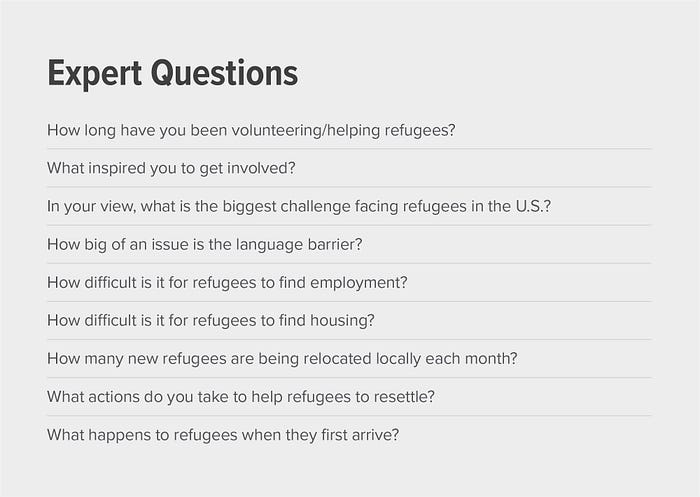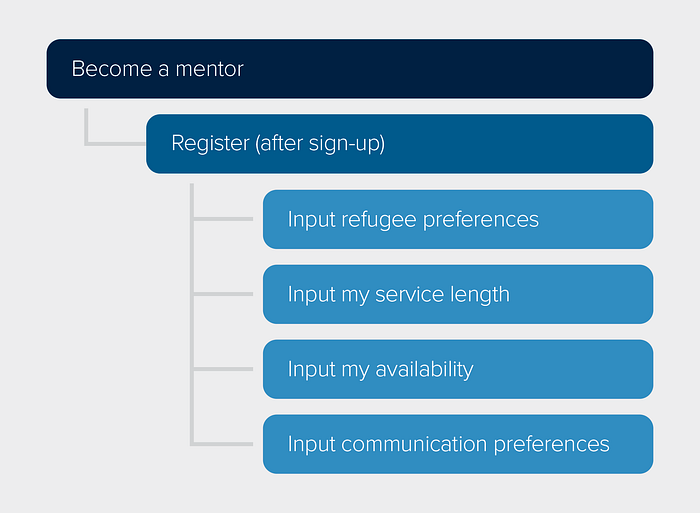Helping refugees through mentoring — A UX case study

As we pulled into the parking lot for a follow-up visit with a refugee family, (pictured above) to our surprise, they were loading a moving truck. They were preparing to move to another city 20 miles away. The explanation we got was that they found a cheaper apartment. Mom, Dad, and eleven kids were moving to a new apartment.
Refugees who are legally admitted into the United States face a difficult road as they try to assimilate into a new culture with different customs, laws and language requirements. Many struggle to become self sufficient, to find permanent homes or to ever feel completely settled.
Our team was challenged to design a solution that would provide refugees with resources and tools to help them make the difficult transition to life in the United States. This was an incredible opportunity to learn what existing solutions were working, what could be improved upon, and if there was something missing that needed to be designed.
Initial goals for this project:

Role/Process:
I led the design team through research, prototyping, visual design and testing. We collaborated with project sponsors through each phase.

We began our research by listing out our assumptions about the issue.

Capturing Qualified Insight:
At the time, our group had no idea how big the problem was or what resources were currently available. My first priority was to talk to some experts. I coordinated multiple interviews with dedicated professionals and community volunteers to get their perspective. Two of our expert interviews were conducted on location where, upon arrival, relocated refugees first meet with case workers and gain access to housing and other necessities. Another interview was conducted at a donation drop off site in a refugee apartment complex in SLC. We also spoke with volunteers who had spent 100+ hours working directly with refugees. With each of these individuals my goal was to learn what was preventing refugees from becoming self-sufficient and completely settling into the community.

Much of what was discovered from these interviews was inline with assumptions we had about challenges with language, employment, and housing. However, insights into where volunteer efforts were failing caused us to dig deeper. We started asking questions about what citizens typically do to help refugees and what was and wasn’t effective. We initially thought refugees would be the primary users of our solution but many of the problems seemed to be tied to the lack of volunteers who were willing to get personally involved.
Key Findings on volunteer efforts:
- Donations are always needed, but they don’t help refugees become self reliant. In some cases donations promote reliance on donations.
- Building personal relationships with refugees is one of the most effective means to help them settle into a new country and culture.
Meeting Refugees:
With some background on the issues, I wanted to see if the perspective of the experts matched up with that of refugees. With the guidance of Jeff Hanson, a dedicated volunteer, we visited an apartment complex where several refugee families were living. I wanted to learn what challenges they faced when they arrived in the U.S., whether they had a mentor and if so, what their experience was.

After walking around, and knocking on a few doors, I set up three interviews with refugee families. One family came from a refugee camp in Thailand and two were from Congo. Their challenges were similar: language, employment, housing and feeling like they belonged in the community. We inquired about their experience with mentors. Each family had been assigned a mentor but feedback about their experience was mixed. Interactions were infrequent and were usually limited to phone calls. We also learned that access to technology is limited. Neither of the families had a desktop or laptop computer in their homes but they did have smartphones.
Surveying the Community:
The final piece of our research was gathering data from the community. We sent out a survey through social media to see what people understand a refugee to be, if they had ever interacted with a refugee and whether or not they had volunteered to help refugees. Looking back I wish we had asked questions that would have targeted specific volunteer activities individuals were doing, and if they were eager to do more. I missed the mark on that one.

Step 2: Define
Shifting the Focus
Throughout the research phase a few ideas around language, housing and employment were discussed as possible problems to solve. However, as we analyzed the research in terms of what was most needed and what would have the greatest impact we agreed that a site facilitating mentoring for refugees was the best direction. We met with our sponsors, presented our research and a decision was made to move forward.

Our initial ideas targeted how a refugee would learn about a mentoring program and sign up to be mentored. However, we changed the primary user of the site to be volunteers after learning that most refugee families have limited access to technology both in terms of hardware and bandwidth. We also realized that the greater challenge is finding volunteers who are willing to become mentors.
Getting to know Karen:
After settling on a target user (volunteer mentors) we created our persona based on what we knew:
- Many people in the community had already volunteered to help refugees or had donated goods or money.
- Many want to interact with refugees on a personal level.
- People who volunteer are a busy bunch. They need a solution that fits into a tight schedule.

Building the Journey:
Creating a user story map was a challenging aspect of this project. The user goals were fairly simple to define:
Determine if I want to be a mentor.
Become a mentor.
Control my experience as a mentor.
Act as a mentor.
Document my experience as a mentor.
The process of breaking down these goals into narratives and tasks was not as simple. We debated nearly every task. After several frustrating hours, and a few meetings with sponsors, we realized that many of the flows we were creating were based more on personal bias rather than our research and the goals and limitations of our persona. This small breakthrough was not only key to completing the user story map but it was also a great reminder that Karen (mother of three) is the ultimate decision maker.

Step 3: Design
Sketching the Interface
Our first wave of sketches were targeted at refugees and how we might foster interest in a mentoring program. However, as the focus shifted to the mentor as the primary user, wire frames for marketing pages were aimed at showing volunteers how mentoring could fit into a busy lifestyle. A page for logged-in mentors depicted a dashboard with options for communicating with refugees via instant messaging, email, calling, and video chat. Other pages showed how mentors could control who they were comfortable mentoring and the days and times of the week they were available.

Step 4: Prototyping
Giving the mentor control
Our first prototype was created to test the user’s ability to set-up their account and interact with an assigned refugee. In testing these tasks, users were able to go through the process just fine, but feedback on the lack of content and context encouraged us to move quickly to a higher-fidelity prototype.

Step 5: Testing
Refining the Flow
Testing on the high-fidelity prototype revealed several needed refinements. Here is some of the feedback from user testing:
-Setting up each channel of communication is confusing/takes too long.
-Not sure what “single” means.
-Thought “instant messaging” meant social media.
-Don’t understand what “special instructions” are.
-Would be helpful to see times to contact refugee on dashboard.
-How do I create an account on appear.in? Does refugee have an account?
-Did not see the progress bar in sign up process.
-IM looks too much like native texting.
-Thought size of journal box limited character entry.
-Clicked on top home button to try to interact with refugee.
-Thought the share icon was a go back or undo button.
Visual Design:
After implementing final modifications based on the user testing, we moved forward with the interface design. Layouts for both mobile and desktop were included.



Results and Conclusion:
My Biggest Learning
The research on this project wasn’t easy, but it was worth it. Without input from experts, volunteers, and refugees we would have been trying to solve problems based on news stories and search results. Now with that said, we didn’t actually solve any problems. The site hasn’t been created yet. But, we did validate our solution with an expert. At the “completion” of this project we visited Mark Burton, Case Management Supervisor at Catholic Community Services to get his thoughts on what we had created.

We asked Mark to test our high-fidelity prototype and give us his honest opinion on whether or not this would be a viable and effective tool to get more volunteers to become mentors. His feedback was very positive. In his words, “this would be a great solution for us…we would have to add our language and branding.” He also thought it would work for a grass roots organization looking to help refugees who have been in the U.S. for at least two years. Big thanks to Mark for meeting with us twice to provide insight and feedback
And finally…
I sent Mark a note with a link to the prototype indicating my desire to see this actually be built. If and when that happens I would want to get an MVP programmed so we could beta start testing the communication features. I would also want to start driving traffic to the site to determine the effectiveness of the marketing pages.
Thanks for reading. Reach me on LinkedIn: www.linkedin.com/in/jwbritton or email me at jbritton35@gmail.com

